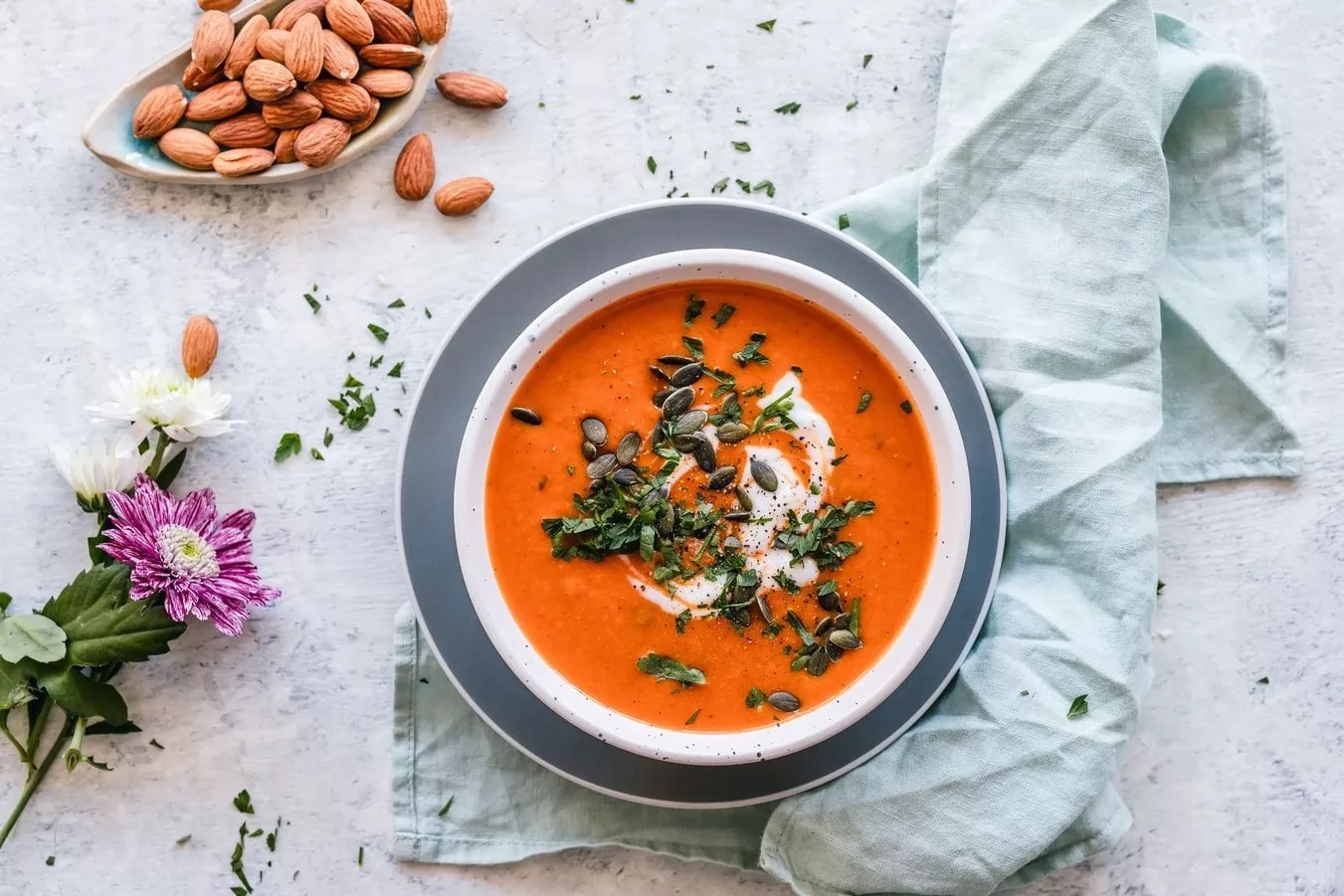Summary of our market study
The French soup market is estimated at 475 million euros in 2022
from 2020 onwards, the European industrial soup market experienced a downward trend in production and demand. While European soup production stood at $2.6 billion, with negative annual growth of -1.3%, the French market was harder hit, with an 8% drop.
France accounts for around 15% of European production, but its domestic consumption has fallen considerably.
Continental Foods and Unilever dominate the market through brands such as Liebig and Royco.
The shift in demand towards classic, natural and organic soups is noticeable, with Knorr leading the organic segment and brands like La Potagère focusing on the wellness positioning.
Decline in the industrial soup market
Whereas between 15 and 20 million French people used to consume soups on a regular basis, the figure has now dropped to just over 16 million.
New generations are turning away from soups, regarding them less as a "real meal".
This change has led to a marked shift from instant and dehydrated soups to fresher variants, perceived as the closest to home-style quality.
While demand for hot soups declines in winter, consumption of cold soups such as gazpacho increases in summer.
Manufacturers are adapting to consumers' rejection of the glutamate used to amplify flavors and of salt.
French soup market players
- Continental Food France takes center stage thanks to its dominant presence and the strength of its Liebig and Royco brands.
Unilever France is another global giant with a strong presence in soup production with its Knorr brand - PepsiCo France is also present in the soup market.
- La Potagère, a brand that stands out for its commitment to naturalness and well-being.
- Soup'Idéale artisanal soup
- Carrefour, supermarket chains and Picard Surgelés offer their own private label products
to understand this market
Detailed content of our market study
 Inforamtion
Inforamtion
- Number of pages : 35 pages
- Format : Digital and PDF versions
- Last update :
 Summary and extracts
Summary and extracts
1 Market overview
1.1 Market overview and definition
Soup is a liquid culinary preparation, most often based on cooked vegetables, which can be served hot or cold.
Generally speaking, soup is made up of vegetables and legumes, such as beans or lentils, but these ingredients are sometimes combined with animal proteins (meat, fish, milk, eggs, cheese), fats or oils.animal proteins (meat, fish, milk, eggs, cheese), fats (lard, butter, oils, creme fraiche) and, more rarely, fruit.
Different types of soup can be distinguished (non-exhaustive list):
- Vegetable soups (fresh, canned, instant, dehydrated);
- Cold soups (gazpacho);
- Fish soups (bisque).
A standard of practice exists for vegetable soups, to provide consumers with a guarantee of quality: to qualify for the "soup" label, a product must contain at least 40% vegetables. Otherwise, the product will be considered a vegetable juice.
In 2023, the European soup production market was worth 2.29 billion euros. While the French soup market had been on a downward trend since 2013, in 2023 soup production sales in France rose by 35%, and the coverage rate, which had fallen considerably in recent years, rose by 9 percentage points to 37%.
While soup brands have redoubled their efforts in recent years to better segment their products and give industrial soups a new commercial lease of life with new recipes, inflation and the French's consumption trade-offs are driving down sales in the most highly-valued sectors, such as organic soups, which fell by 10% in volume in 2023.
1.2 The European market for industrial soups
As the products in the soups category vary greatly from one region of the world to another, the European market will be presented in this section, rather than the international market, in order to obtain comparisons on comparable products.
by way of example, the Asian soup market is significant, but is driven almost exclusively by noodle soups, which makes the comparison of little interest here.
In ****, European soup production will reach *.** billion euros, compared with *.** billion in ****; this drop can be explained almost exclusively by the UK's exit from the European Union.
Value of soup production Europe, ****-****, billions of euros Source: ****
Breakdown of production by country
Europe, ****, % of European total Source: ****
It's interesting to observe the evolution of European production by country, as the top * countries stand out very clearly.
Based on a market value of *.** billion euros in ****, we obtain the production value of the top * European producer countries, as shown in the graph below.
Soup production Europe, ****-****, millions of euros Source: ****
In ****, the UK was the leading producer of soups, a position it lost to Germany in ****. This is due to the fact that these two countries experienced completely reversed growth trajectories over the ****-**** period: german ...
1.3 French market losing momentum
Domestic consumption can be used to estimate the size of the French market. Domestic consumption can be estimated using the following formula: domestic production + imports - exports. This gives a French soup market of around *** million euros in ****.
If French soup production were to follow the same downward trend as the European market, in **** French production would amount to *** million euros, an increase of **% on the previous year.
According to LSA, in ****, the Knorr and La Potagère brands accounted for ** million euros in sales across all channels, while the two brands accounted for **% of the soup market. Thus, according to LsaConso, the soup market can be estimated at *** million euros in the first period of ****.
Soup market value France, ****-****, millions of euros Source: ****
The French market is therefore in slight decline. In value terms, the loss between **** and **** amounts to *** million euros.
However, by ****, France will account for approximately **.*% of European production.
Foreign trade in soup production France, ****-****, millions of euros Source: ****
The evolution of the coverage rate over the period ****-**** consistently illustrates the loss of momentum of French soup production, with the level of exports falling below the level of imports in ****. A revival in export ...
2 Demand analysis
2.1 Vegetable and soup consumption habits in France
Vegetable consumption in France:
The results of a **** Ipsos study highlight social, generational and gender inequalities in eating attitudes and behavior. The main findings are as follows:
Favored social categories (***), respectively **% vs. **% and **% vs. **%. There are also generational disparities. Young adults (***) show the lowest rate, with only **% declaring daily vegetable consumption. Vegetable consumption also highlights gender inequalities. Overall, women are more attentive to food quality than men. Less than half of men(***) eat vegetables every day, while **% of women include these foods in their daily diet.
These figures underline the existence of social, generational and gender divides when it comes to eating habits and attention to food quality.
Poll: How do you perceive the "eat * fruits and vegetables a day" recommendation? France, in ****, in % Source: ****
However, a study carried out by OpinionWay in **** highlights the impact of inflation on French fruit and vegetable consumption. While for **% of French people, eating * fruits and vegetables a day is a fundamental part of their diet, **% of respondents say they find it difficult to achieve this goal, and **% say it's a luxury difficult to afford because of inflation. According to Interfel's **** consumption report, the amount spent by households on fruit and vegetables continues to fall, ...
2.2 Other factors explaining the drop in demand
The demographic factor:
New generations are less inclined to buy industrial soups because they no longer perceive soups as a "real" meal, and thus tend to exclude them more or less unconsciously from their consumption habits[***].
Finally, industrial soups originally appealed to consumers mainly for the following reasons:
No preparation ; Quick and easy ; Low cost; Individual portions; Relatively wide choice.
Now, with the exponential growth of the home-delivery market, consumers can enjoy almost all these benefits, and the offer is far more attractive to the younger generation.
Questions about product composition:
Doubts about the naturalness of industrial soups are increasingly present in consumers' minds at the time of purchase, particularly in relation to the presence of preservatives. Current dietary trends are calling into question the quality of industrial products and their nutritional vitamin content.
This culture of well-being, often at the forefront of our societies, has had the main consequence of diverting demand from industrial soups to homemade soups, where consumers can have total control over the composition of their soup.
The direct consequence of this phenomenon is a drop in demand for dehydrated and instant soups, in favor of fresh soups, which are the closest products to home-made soups, and ...
2.3 Different types of soup
French soup consumption revolves around several types of soup, divided between two departments: fresh and ambient.
Soup sales by type France, ****, % (***) Source: ****
The types of soup found in the ambient department are :
Liquid soups Dehydrated soups Instant soups
According to LSAConso, sales of liquid soups totaled *** million euros in ****, up *.*% on the previous year. Dehydrated soups accounted for €** million in revenues, up **.*%.
Breakdown of soup sales by type France, in ****, in millions of euros Source: ****
The following types of soup can be found in the fresh produce section:
Vegetable soups Fish and shellfish soups
The ambient soups aisle saw renewed growth in the last season, from October to the end of March ****, with volumes up *.*% and valuation up **.*%, supported by inflation compared to the same period in ****.
2.4 Soup, a product whose demand remains seasonal
Soups and broths are experiencing difficulties. This summer's heatwave also had a negative impact on these weather-sensitive markets, with sales down *.*% in value terms in period *. The market is facing competition from homemade products. However, the soup category is enjoying a resurgence of interest, notably through products such as gazpacho and premium alternatives. These products offer healthy recipes, rich in nutritional value, and at an affordable price given the rising prices of fresh vegetables, particularly in the organic segment [***].
In recent years, demand for "summer" cold soups has grown exponentially, with gazpacho in particular.
Alvalle gazpacho consumption France, ****-****, millions of consumers Source: ****
This product, which appeals to a very large proportion of consumers, enables producer companies to counterbalance the seasonal nature of soup in winter with a seasonal product in summer.
Alvalle brand gazpacho is the best-selling gazpacho in France. The graph above perfectly illustrates this rise in demand for cold soup, which is mainly consumed during the summer months. Over the period ****-****, the number of consumers in France rose from *.** million to *.** million, representing a CAGR of **.**%.
2.5 Organic as the future of the soup market?
According to [***].
Organic share of the soup market France, ****, millions of euros Source: ****
Liebig is the leader in this sub-segment, with estimated sales of around ** million euros, representing a **% market share and growth of *.*% [***].
2.6 France's favorite brands
The graph below is based on OpinionWay's survey of the French people's favorite brands in ****. For each brand, the percentage corresponds to the proportion of respondents who answered "yes".
Knorr is France's favorite soup brand, with **.*% of respondents saying they liked it. Alvalle is the least popular soup brand, with only **.*% of respondents saying they liked it.
French people's favorite soup brands France, March ****, in Source: Opinionway Marque préférée des Français survey conducted in March **** - Base: representative sample of *,*** French Internet users aged ** and over The graph below compares the level of appreciation of * soup brands according to the age category of respondents. It's difficult to see a firm trend in terms of age category, since for Knorr and Liebig, the **-** age group is the one with the lowest appreciation rate, but for La Potagère it's the **-** age group, and for Alvalle it's the over-**s. Comparison of the level of appreciation of * soup brands according to age category France, March ****, in Source: Opinionway Marque préférée des Français survey conducted in March **** - Base: representative sample of *,*** French Internet users aged ** and over The graph below compares the approval ...
3 Market structure
3.1 Soup market value chain
A possible value chain for the soup market is as follows:
Raw materials: the basic ingredients for soup production, such as vegetables, spices, meat or fish, are grown or purchased by producers. Production: the raw materials are transformed into soups by the soup producers, who may be industrial or small-scale enterprises. Packaging: once the soup has been produced, it is packaged in cans, sachets or jars for distribution. Distribution: packaged soups are then distributed to retailers, who may be supermarkets, delicatessens, convenience stores, restaurants or canteens. Marketing and advertising: soup manufacturers use various marketing and advertising channels to promote their product to consumers, such as television, social media, print ads and promotional events. Retail: consumers buy soup at retail outlets such as supermarkets or delicatessens. Consumption: consumers prepare and consume soup at home or in restaurants.
3.2 Changes in market structure
The creation of a giant:
In ****, Spanish group GB Foods took over European competitor Continental Foods, known for its Royco and Liebig soup brands.
Investment fund CVC Capital Partners, owner of Continental Foods, has sold its business to GB Foods, part of Barcelona-based Catalan family group Agrolimen for a sum valued at around *** million euros. Established in **** as a division of the Campbell Soup Company, Continental Foods, headquartered in Puurs, Flanders, had been acquired by CVC in **** for *** million euros.
Prior to the takeover, Continental Foods, present on the Belgian, French, German, Swedish and Finnish markets, employed around a thousand people at four production sites in Europe, including two in France, at Liévin (***). It generated annual sales of *** million euros, with brands such as Devos & Lemmens, Royco, Liebig, Erasco and Bla Band. This portfolio complements that of GB Foods, which is present in Spain, Italy, the Netherlands and the countries of the former Soviet Union, notably with its Grand'Italia pasta and sauces brand and its Gallina Blanca bouillon brand, created in Barcelona in ****.
A market dominated by two global players: GB Foods and Unilever
Market share of the main soup brands France, ****-****, millions of consumers Source: ****
The main players ...
3.3 Production structure in France
This section uses data supplied by INSEE and ACOSS under NAF code **.**Z "Manufacture of other food products n.e.c.", a category in which soups account for the bulk of production.
Number of companies manufacturing soups France, ****-****, in number of companies Source: ****
Between **** and ****, the number of companies operating in the industrial soups market increased by ***. The distribution of companies across the country is not homogeneous, since most of the companies present in France are located in the Ile de France or in the south of France, as the map below reveals:
The above chart is also based on data from NAF code **.**Z Manufacture of other food products n.e.c. The number of employees, meanwhile, has risen steadily since ****, from **,*** in **** to **,*** in ****.
4 Offer analysis
4.1 Product typology
Industrial vegetable soups are sold in three possible forms[***]:
Fresh soups: the closest industrial product to the homemade variety, these soups are also the most expensive due to their short shelf life and high fresh vegetable content; Brick soups: sterilized at high temperatures, these are still a relatively high-quality product in terms of vitamins and nutritional qualities, despite a regular problem with salt content; Sachet soups: these are the soups with the fewest vitamins and the most additives, since the raw materials used are themselves dehydrated.
Generally speaking, there are six categories of soup:
Clear broths ; Creams and veloutés ; Minestrone; Soups; Fish soups; Cold soups.
4.2 Innovative industrial soups
In order to revive French consumption of industrial soups, producer brands had taken the gamble of diversifying their offering, with the aim of offering consumers a wide choice of selections and thus trying to appeal to and win the loyalty of a broad panel of occasional consumers[***].
In fact, according to a survey carried out by Food Navigator in ****, **% of French people were inclined to try new recipes for industrial soups. The creativity of the offer is therefore a key element of demand, knowing that the multiplicity of choices for combining vegetables is very important.
With this in mind, the leading companies on the French market have developed product ranges such as the following:
"L'ethni-soupe ", the soup that makes you travel:
Knorr: New Delhi soup ; Maggi: Escapade soups; Liebig: Thai soup; Royco: instant oriental soup.
Traditional soups ", which recall the tradition and original flavors of soup:
Knorr: Grandmother's Secret; Maggi: Saveurs à l'Ancienne ; Liebig: Ma Soupe Maison.
Soups echoing " sweetness ":
Knorr: Douceur de Knorr ; Liebig: Doux Plaisirs.
In ****, exoticism continues to be a major inspiration for those involved in the food sector. This year, Liebig offers soups with Thai and Indian flavors, while Knorr launches dehydrated soups inspired by China and ...
4.3 The latest trends
In the instant soup segment, the undisputed leader, Royco (***), with a **% market share by value, is sparing no effort. "Our exotic recipes attracted ***,*** households in ****," says Élise Méjane, Group Manager. Packaging has been redesigned and three new recipes, including two exotic ones, were launched in September. Royco's core target group, made up of seniors, teenagers and students, appreciates the diversity of the ** recipes on offer, all of whom are keen to get away from it all. In a more upmarket segment, at around €*.** for a box of three sachets, Japanese broth specialist Ariaké is also enjoying success. "The French are familiar with miso soup, which has enabled us to record steady growth over the past four years", notes Laurent Seguin, Sales and Marketing Director for Europe.
In the area of liquid soups, brands are responding to the need for reassurance by emphasizing natural, local or organic ingredients. "In ****, we focused our efforts on local consumption and have just enriched our French vegetable range with a velouté and a mouliné. They are available in * liter and * x ** cl formats, a big first for us, to meet the needs of individuals or couples", testifies Irene Barufatto. In the fresh produce section, GreenShoot ...
4.4 Price trends for soups
According toINSEE, price trends for products such as soups have been rising overall for a number of years. Since ****, prices for food products sold off the fresh shelves (***) have risen significantly in supermarkets and hypermarkets. Prices rose by **% between **** and ****, by over **% between **** and ****, and by a further **% between **** and ****.
To obtain the price index, we use NAF code **.**Z - Manufacture of other food products n.e.c. with base *** and ****.
Evolution of the soup price index France, **** - ****, base *** Source: ****
for information purposes, the table below shows the prices of representative products on the soup market in supermarkets.
Source: ****
Two factors influence soup prices (***):
Depending on the category of distributor (***), the price of a soup can vary: at Auchan, "Pursoup Velouté ** légumes de Liebig" soup costs €*.**/L, at Carrefour it costs €*.**, at Monoprix it costs €*.**/L and at Casino it costs €*.**/L.
Depending on the brand, the price of the product also varies: according to La Nutrition, despite the fact that Knorr soups have a much lower real vegetable content than their competitors (***), Knorr's prices are among the highest on the market, at almost €*.*/L.
To support consumers in this inflationary context, brands are mobilizing. Liebig has organized ...
4.5 The health aspect
According to a survey carried out by ** millions de consommateurs in ****, do industrial soups have any interesting nutritional virtues? "According to the results of our test, nothing is less certain", says the association. And this despite the efforts of manufacturers to reduce the salt content of this type of winter soup.
** millions de consommateurs took the time to test the composition of ** industrial soups, available in supermarkets and organic stores. They found that industrial soups do not contain enough fiber and vitamins.
According to their measurements, "the vast majority of our soups do not exceed one gram of fiber per serving", explained the testers. When it comes to vitamins, the situation is not much better: all the references analyzed had "very inadequate" levels. On the other hand, the pumpkin and mixed vegetable soups did contain a "significant amount" of provitamin A, or beta-carotene.
The tests carried out by ** millions de consommateurs also looked for pesticides, listed the ingredients and established their Nutri-Score. They revealed that most industrial soups actually contain fats, such as sunflower oil or crème fraîche. But to look good on the plate, they also contain natural or synthetic flavors, as well as thickeners, "such as ...
5 Regulations
5.1 Regulatory framework
According to BusinessWirecanned soups often contain many unhealthy preservatives. Another negative factor is the inability to control fat intake in canned soups .
The Huffington Postaccording to the Huffington Post, aromatic and additive powders (***) are added to soup recipes at the factory to give them extra flavour. Glutamate, according to EFAP Students is, however, one of the most harmful additives to health, correlating with diseases such as Alzheimer's, Parkinson's, obesity and diabetes. However, institutions do not consider this a "major problem" for the food industry, despite the fact that an industrial soup contains up to *,*** mg of glutamate per serving.
In **** , Europeanauthorities legislated on the addition of glutamate to industrial preparations, capping it at ** g/kg. No maximum quantities are mentioned for seasonings and condiments.
To further balance relations between producers and suppliers, the "food law" passed in October **** should influence industry practices. The aim is to reverse the construction of prices, which will be based first and foremost on production costs, but also to balance the balance of power between producer and distributor in food matters[***].
The law provides for
A cap of **% in value and **% in volume on promotions; A **% increase in the loss leader threshold (***), meaning that products sold ...
6 Positioning the players
6.1 Market segmentation
- GB Foods
- Unilever Groupe
- Soup'Ideale
- Picard Surgelés
- Sill Entreprises
- Sauces & Créations
- Alvalle
- Ferme d’Anchin
All our studies are available online in PDF format
Take a look at an example of our research on another market!
 Choosing this study means :
Choosing this study means :
Access to more than 35 hours of work
Our studies are the result of over 35 hours of research and analysis. Using our studies allows you to devote more time and added value to your projects.
Benefit from 6 years' experience and over 1,500 industry reports already produced
Our expertise enables us to produce comprehensive studies in all sectors, including niche and emerging markets.
Our know-how and methodology enable us to produce reports that offer unique value for money.
Access to several thousand articles and paid-for data
Businesscoot has access to all the paid economic press as well as exclusive databases to carry out its market research (over 30,000 articles and private sources).
To enhance our research, our analysts also use web indicators (semrush, trends, etc.) to identify market trends and company strategies. (Consult our paying sources)
Guaranteed support after your purchase
A team dedicated to after-sales service, to guarantee you a high level of satisfaction. +44 238 097 0676
A digital format designed for our users
Not only do you have access to a PDF, but also to a digital version designed for our customers. This version gives you access to sources, data in Excel format and graphics. The content of the study can therefore be easily retrieved and adapted for your specific needs.
 Our offers :
Our offers :
the soup market | France
- What are the figures on the size and growth of the market?
- What is driving the growth of the market and its evolution?
- What is the positioning of companies in the value chain?
- Data from several dozen databases
Pack 5 études (-25%) France
- 5 études au prix de 74 €HT par étude à choisir parmi nos 1200 titres sur le catalogue
- Conservez -25% sur les études supplémentaires achetées
- Choisissez le remboursement des crédits non consommés au terme des 12 mois (durée du pack)
Consultez notre catalogue d’études sectorielles


















